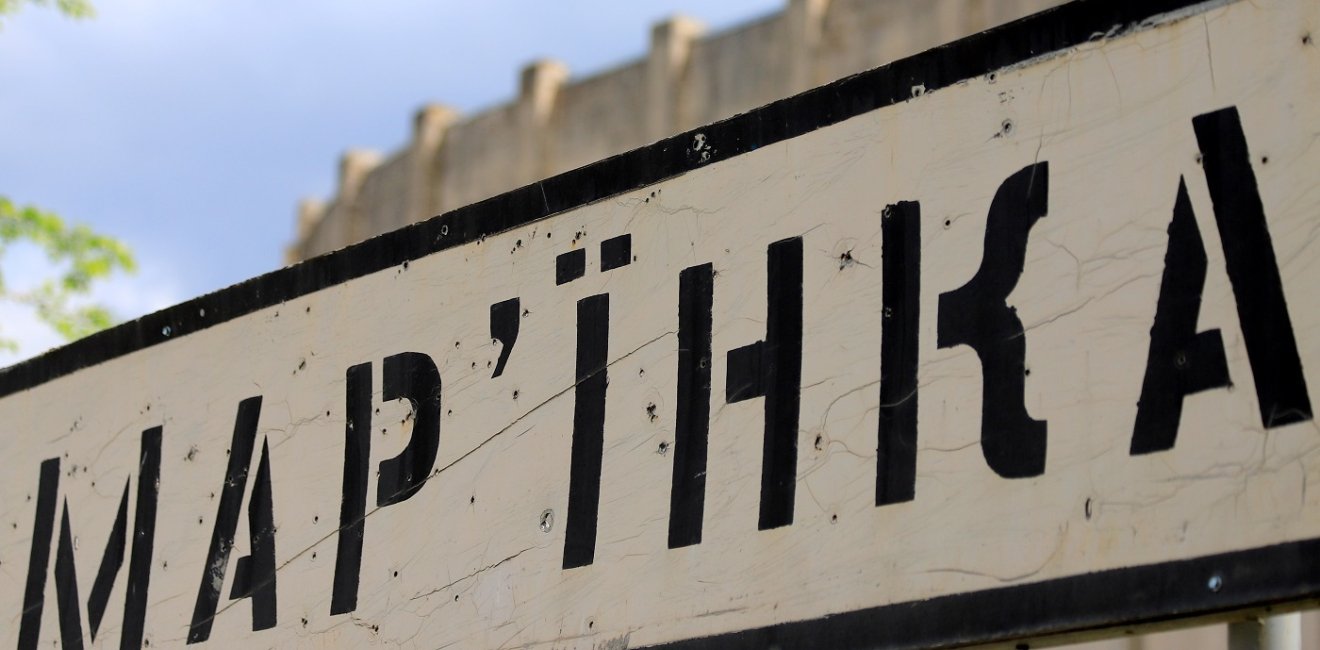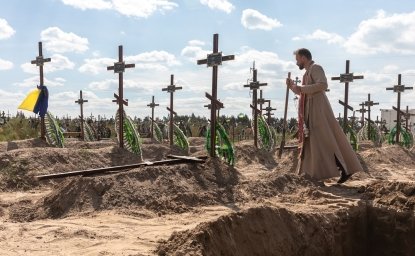
A blog of the Kennan Institute
It is called Mariinka, an eastern Ukrainian town that once boasted 10,000 occupants, a majestic cathedral, and a prosperous tire factory. But after a year of pounding by Russian missiles, bombs, and artillery shells, it is all but destroyed.
The famed golden dome of Mariinka’s basilica is ruined, as are most of the schools, stores, and public buildings. But a contingent of Ukrainian troops still clings to the town’s center, which comes under frequent attack by Russian forces. The once proud city has become a no-man’s-land riven by trenches and machine gun nests and covered in mud and snow, its drab colors punctuated only by the vivid reds and yellows of exploding shells. The city sits on the front line of freedom as Ukraine fights to maintain its independence in the face of Putin’s “special operation.”
Mariinka was our mission objective for the day. As head of a nongovernmental organization providing Ukrainian relief to the Territorial Defense Forces of Ukraine (TDF), I was responsible for delivering humanitarian supplies to the men and women citizen soldiers who fight on to resist the onslaught from the east. In the course of the mission, which took place in early January, my team and I delivered two ambulances and individual first aid kits, along with solar-powered lamps, trauma packets, bandages, and other medical supplies, to save lives and offer comfort to those living in dark basements and bunkers.
In many ways, the town is typical of scores of cities located in the self-styled Donetsk People’s Republic and its breakaway partner, the Luhansk People’s Republic. With leaders hand-picked by Moscow, these provincial governments are nothing more than hollow puppet regimes created by Vladimir Putin and his allies in a vain attempt to bring false legitimacy to what is actually a cold-blooded invasion. The Russia leader hopes that the Potemkin republics will mislead some observers into believing that the conflict is a Ukrainian civil war, which might lessen the sanctions imposed on his country for its brutal invasion of a peaceful sovereign nation. Few of those familiar with Putin and his KGB-inspired tactics are confused by his diversionary speechifying.
Before the outbreak of the war, Ukraine’s eastern provinces were on a gradual but firm track of economic and social development, aided by unprecedented financial support from the central government in Kyiv. But much of that progress took place before Viktor Yanukovych became president of Ukraine in 2010. The Russia-backed official began a clandestine effort designed to force the country back into an alliance with Putin rather than seeking integration with more progressive organizations in Europe.
Yanukovych’s strategy was accompanied by a wave of corruption that has seldom been equaled in southeastern Europe. As an example, the president built himself a $75 million palace, a glaring affront to citizens struggling with abject poverty. As a result of the corruption and pro-Russia orientation, the Ukrainian parliament voted Yanukovych out of power in 2015. He quickly retreated to Putin’s protection, from which he launched a concerted effort to encourage Donetsk and Luhansk oblasts to secede from Kyiv and become members of the Russian Federation. War soon followed as Putin sent armies of “little green men”—soldiers in green fatigues without insignia—into the two breakaway regions in a poorly disguised invasion.
Using strategies from the Soviet era, Yanukovych bombarded the eastern republics with pro-Russia propaganda, reconfigured their free-market economies in the Russian model, and educated children in a spirit of brotherhood with Russia. Instead of enjoying gradual development as parts of Ukraine, Donetsk and Luhansk oblasts now face the horrors of war, and suffering has mounted as economic ties to Russia have been severed. In the same way that Germany was divided following World War II, the two regions have been split off from Ukraine in the guise of illusionary “people’s republics.”
Meeting in a Schoolyard
As we reached Mariinka and began to distribute our humanitarian supplies, the winter sky was bright and untroubled by shrieking Russian artillery shells or drones. Members of the Ukrainian army were cheered by the supplies, and as we reached a wrecked school, a few soldiers emerged from their shelters to claim the solar-powered lamps and medical kits.
The school stands as a perfect symbol of what has happened to Ukraine since the full-scale Russian invasion began in February 2022. All of the windows have been blasted to bits, the classrooms stand exposed to the elements, and much of the substructure has suffered damage. Our local guides from the TDF explained that Russian troops often target schools and kindergartens to spread terror and increase the economic and social burdens on the Kyiv government.
The school building can no longer be used for educational purposes; in that the Russians have succeeded. But Putin’s shells have failed to break the spirit of Ukraine’s children. They are still drawn to the building, where they use the playground to meet friends and socialize.
Upon arriving near the entrance of the school I noticed three young teenagers sitting near the school’s small playground, and immediately approached them. The jibs and jabs of the youngsters enlivened the otherwise silent schoolyard. It was clear that terror had not taken root in the hearts of these boys. However, that is not the most notable of Russia’s failure.
Before the invaders were driven out, the students had been taught that Westerners were “NATO monsters” bent on destroying Ukraine and killing its people. The only proper response, these young teens had been instructed, was for them to use cell phones to report our location to the Russian army so that it could direct artillery our way. Despite the threat, volunteer agencies like mine have not slackened in our efforts to provide Ukrainians with the supplies needed to patch wounded limbs and strengthen the flame of freedom.
To symbolize our commitments, we wear patches emblazoned with the flags of the United States the UK, the EU, and Ukraine. Along with our humanitarian supplies, these banners help demonstrate that Russian claims about the malevolence of Western nations and organizations are absolute lies. I gave them all patches, along with a small board game and some other supplies and a little money ($65.00) in the hopes of sharing some Christmas spirit, and thought this was the perfect opportunity to shed some light in an otherwise dark time. As I interacted with the boys, I tried to explain to them that I was an American, before one of my interpreters appeared and explained why I was there. The three boys whom we encountered on the playground made clear they were shocked to see an American in their town. They then asked to have photos taken with the “NATO soldier,” and said their friends would be quite envious at our encounter, as it was hard to believe. We tried to explain that we were not soldiers but humanitarian workers. That mattered little to the boys, who seemed to be intrigued by their interaction with benevolent visitors who brought a moment of normalcy to the stricken area.
At that point, our peaceful interlude was interrupted by war.
Our friends from the TDF ran up to rush us back to our vehicles. They had intercepted indications that hostilities were about to flare up once again. We later learned that after our departure, three of Mariinka’s defenders were wounded. One died.
On the long ride back to our base, however, my thoughts were not on the danger involved in such humanitarian missions but on the last few words I had left with the young boys. I told them that we would be back, and not only until the victory of brave Ukrainians over their invaders: we would remain with them until their school and their country had been rebuilt so that they could enjoy the blessings of independence and freedom. I told them we would support them in their struggle for democracy, human rights, and civilization, and help them wrench free from the totalitarian past under the imperial domination of Russian dictators, corruption, and aggressive chauvinism.
On that day in eastern Ukraine, I left Mariinka, but a part of my heart is still there. And I am looking forward to the day when I can return, shake their hands and help them rebuild.
The opinions expressed in this article are those solely of the author and do not reflect the views of the Kennan Institute.
Author


Kennan Institute
The Kennan Institute is the premier US center for advanced research on Eurasia and the oldest and largest regional program at the Woodrow Wilson International Center for Scholars. The Kennan Institute is committed to improving American understanding of Russia, Ukraine, Central Asia, the South Caucasus, and the surrounding region through research and exchange. Read more

Explore More in Focus Ukraine
Browse Focus Ukraine
Talking to the Dead to Heal the Living

Ukrainian Issue in Polish Elections


